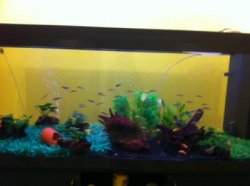TallTree01
Coo, Man
Hey guys,
I've been gathering equipment and supplies for an upcoming aquarium and would like to have a substrate that's not plain white sand. I've been doing some reading online and it seems that the general consensus is that ADA is a good brand.
I've been looking at the Amazonia type as I quite like the color of it but on the site there is 3 different types of it: powder, multi and normal. The normal one is cheapest then the multi then the powder. I gather that it's a difference in size but how substantial is the difference? Is it worth paying twice the amount for smaller gravel?
If you've used this product or something similar how did you get on?
I'd love to see pictures of people's setups with the substrate so I can get an idea as to how it looks in situ.
Thanks
Ooh, almost forgot, is this substrate suitable for catfish like synodontis or corydoras? I would hate for them to hurt themselves on it if it's sharp or anything like that.
I've been gathering equipment and supplies for an upcoming aquarium and would like to have a substrate that's not plain white sand. I've been doing some reading online and it seems that the general consensus is that ADA is a good brand.
I've been looking at the Amazonia type as I quite like the color of it but on the site there is 3 different types of it: powder, multi and normal. The normal one is cheapest then the multi then the powder. I gather that it's a difference in size but how substantial is the difference? Is it worth paying twice the amount for smaller gravel?
If you've used this product or something similar how did you get on?
I'd love to see pictures of people's setups with the substrate so I can get an idea as to how it looks in situ.
Thanks
Ooh, almost forgot, is this substrate suitable for catfish like synodontis or corydoras? I would hate for them to hurt themselves on it if it's sharp or anything like that.

 /www.ukaps.org/index.php?page=guide-to-substrates
/www.ukaps.org/index.php?page=guide-to-substrates


